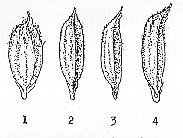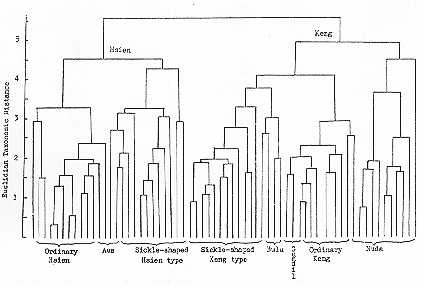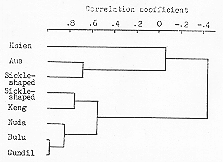1) Beijing Agricultural University, Beijing, China
2) Yunnan Academy of Agricultural Sciences, Kunming, Yunnan, China
The classification of rice cultivars into the Hsien (Indica) and Keng (Japonica) types, established by Chinese people about 2,000 years ago, has now been reconfirmed by contemporary workers (Cheng 1985; Glaszmann 1985; Morishima and Oka 1981; Second 1986). The grain shape as shown by length/width ratio has been considered a useful criterion for distinguishing between the two types. Morishima and Oka (198 1) pointed out, however, that the probability of misclassification by the length/width ratio was quite high. Indeed, this is the case with long- grained glabrous varieties (nuda) and "sickle-shaped" varieties (Fig. 1) of Southeastern Asia, the Basmati type of South Asia, and with the Sadri and Domsiah types from Iran. These have been considered as Hsien types for their slender grain shape, but Glaszmann (1986) as well as Cheng et al. (1985) found that many of them were of Keng type or Keng-cline.
To look more closely into the nature of sickle-shaped varieties, 88 rice cultivars including those and other types, a greater part being made available from the International Rice Research Institute and a smaller part being collected in Yunnan and Sichuan Provinces, were examined with regard to 11 morphological traits and esterase isozymes. The 11 morphological traits are: 1) spikelet shape (Fig. 1), 2) glume color at heading, 3) leaf pubescence, 4) phenol reaction, 5) glume hair state (no hair; short, straight, evenly distributed; long, straight, dense at the upper part of grain; long hairs, not straight, and many long bending hairs), 6) apiculus hair length (measurement), 7) alkali spreading value of grain, 8) interval between first and second nodes of panicle axis, 9) amylose content, 10) length/ width ratio of spikelets, and 11) awn length; of these, 2), 3), 4), 8) and 10) were referred to by Cheng (1985).

Fig. 1. Sketch of ordinary and sickle-shaped rice grains.
1-Ordinary Keng,2-Ordinary Hsien, 3-Partly sickle-shaped, 4-Fully
sickle-shaped.

Fig. 2. Dendrogram of 71 Asian rice Cultivars based on measurements of 11
morphological traits.
Table 1. Frequencies of esterase bands in different varietal
groups of rice
_______________________________________________________________
Band Hsien Keng Keng Hsien Nuda Bulu Gundil Aus
sickle sickle
_______________________________________________________________
4A 4 1 1
5A 1 7 8 2
6A 15 1 1 2
7A 10 24 2 5 2 2
1OA 4 2 9 7 2 3 3
11A 4 9 24 1 13 3 3
12A 9 8 22 2 4
13A 6 8 22 2 6 3 3
Total 15 10 24 12 13 3 3 4
_______________________________________________________________
From the measurements or scores of these morphological traits, Euclidian
taxonomic distances between varieties were computed in all possible varietal
combinations, and a dendrogram was constructed following Yang and Lu (1982).
The dendrogram showed that the cultivars studied (71 in total) were divisible
into two main groups, Hsien and Keng, each subdivided into several small
groups, and that the sickle-shaped varieties were divided into the Hsien and
Keng types (Fig. 2). Of 36 sickle-shaped varieties examined in total, 12
appeared to be of Keng type, indicating that the sickle-shaped varieties with

Fig. 3. Dendrogram showing clustering of different varietal groups based on
frequencies of esterase bands.
similar grain shapes consist of the Hsien and Keng types in the same manner as are other rice varieties.
The frequencies of different bands of esterase observed in these variety-groups are given in Table I. From the data, another dendrogram showing mutual similarities of the variety-groups was computed (Fig. 3). The pattern obtained is in good agreement with those reported by Cheng et al. (1985) and Glaszmann (1986). Many of the sickle-shaped Keng varieties produced semi-sterile F1 plants with both Hsien and Keng cultivars. The position of the sickle-shaped varieties in the process of differentiation of Hsien and Keng types needs more investigations in the future.
References
Cheng, K. S., 1985. A statistical evaluation of the classification of rice cultivars into hsien and keng subspecies. RGN 2: 46-48.
Cheng, K. S., X. K. Wang, Y. X. Lu, J. Luo, N. W. Huang and G. R. Liu, 1985. Studies on indigenous rice in Yunnan and their utilization, 7. A discussion on the rice types in south and western Asia. Acta Agric. Univ. Pekinensis 11: 239-248. (Chinese/English)
Glaszmann, J. C., 1985. A new insight into Asian cultivated rice classification from isozyme studies. RGN 2: 48-51.
_____, 1986. A varietal classification of Asian cultivated rice (Oryza sativa L.) based on isozyme polymorphism. In Rice Genetics, p. 83-90. Ed. & Publ. by IRRI, Manila.
Morishima, H. and H. I. Oka, 1981. Phylogenetic differentiation of cultivated rice, 22. Numerical evaluation of the Indica-Japonica differentiation. Jpn. J. Breed. 31: 402-413.
Second, G., 1986. Isozymes and phylogenetic relationship in Oryza. In Rice Genetics, p. 27-39. Ed. & Publ. by IRRI, Manila.
Yang, H. K. and Z. Y.Lu, 1982. "Numerical Taxonomy in Plant Ecology". Science Press, Beijing. (Chinese)